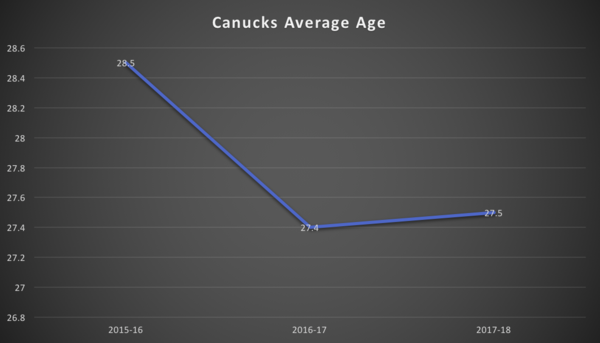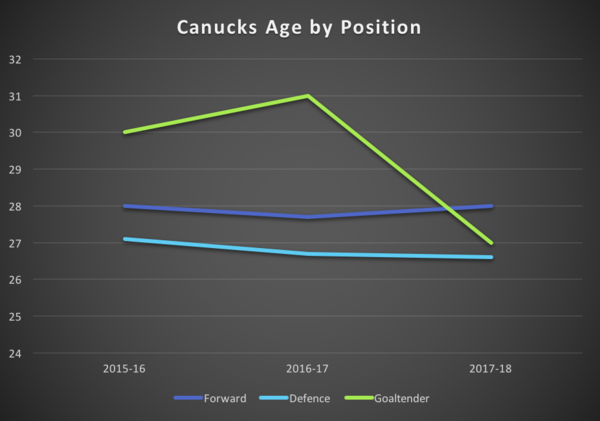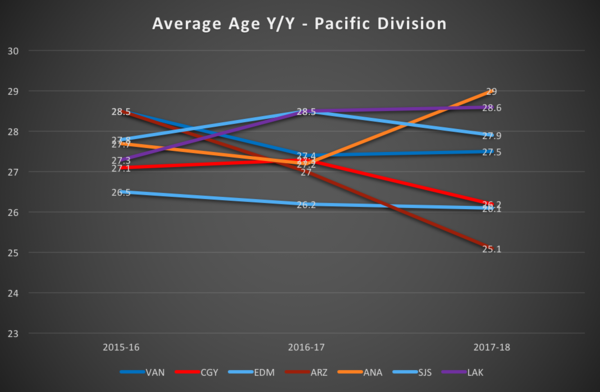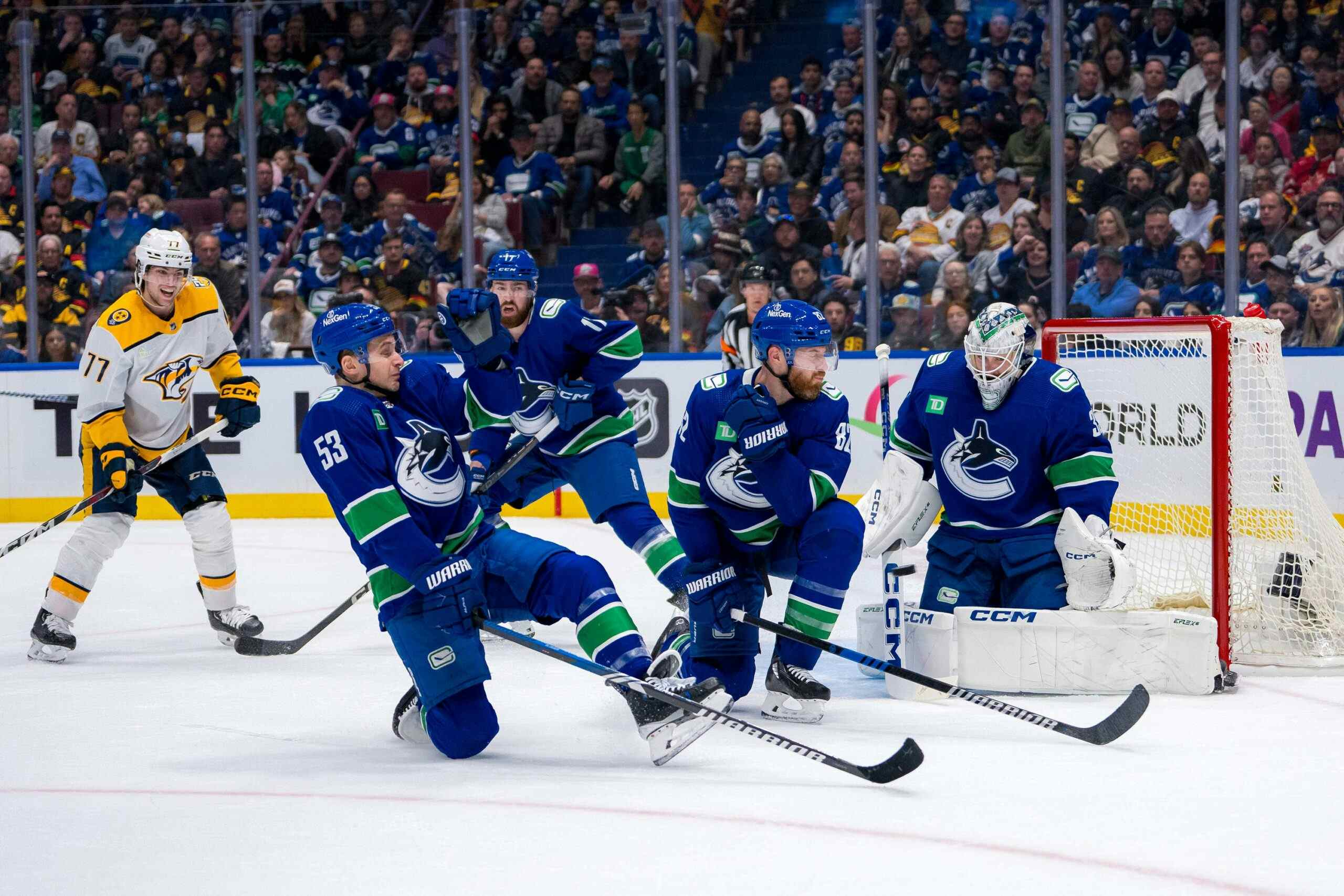Where are the Canucks at with Their Youth Movement?
7 years ago
The Canucks have been undertaking something of a youth movement these past two seasons. They’d needed to shed age for a few seasons prior, but contractual obligations to older players made that an exceedingly difficult exercise.
Now, in the Canucks third year with Jim Benning at the helm, they are beginning to unburden themselves of those veteran contracts. Though the Canucks are still the Sedin twins team, they’re already passing the baton and should shed themselves of its weight entirely this summer.
With that in mind, it’s worth exploring how the Canucks have recaptured youth and continue to do so.
How Does one get Younger?
The obvious answer is to acquire younger players.
If only it were that easy. The thing to remember here is that you’d essentially have to lose 23 man-years to bring that average down. You can only drop a few years per roster spot at that — for every one player that leaves the roster, another has to occupy their spot. Seeing as you can’t get a player younger than 18-years-old, you can only go so far.
Another wrinkle is the obvious but forgettable reality that your incumbent roster ages a year every year. That adds an additional man-year per player to the total value. The concept of player ageing is obvious, but it’s rarely accounted for. You can add a 22-year-old Ben Hutton in 2015, and that’s a great stride towards getting younger. In two years, though, he’s 24 and not contributing positively to your team’s mean age.
And it’s not just that one player, either. It’s however many players you have signed for the following season. For example, the Canucks have 18 players signed for the 2017-18 season, good for +18 man-years.
Before the offseason even begins, you have to start by trying to lose 23 years on your roster before any other additions. Thus you have to try and lose a few man-years in the roster spots that you turn over, and this needs to be done every year. It can’t be a flurry of just get younger and then ride the wave. You have to continually input young prospects while shedding the older players.
Which is something that the Canucks have been doing over the past two seasons.
This Season
The Canucks entered the 2015-16 season with an average age of 28.3 years old, which put them among the most senior teams in the league. That was including 19-year-olds Jake Virtanen and Jared McCann. Needless to say, they needed to continue to get younger. They were able to achieve that by letting many of their unrestricted free agents walk.
With Radim Vrbata and Dan Hamhuis on the wrong side of 30, the Canucks shed years the second they moved on. They achieved that on a lesser scale with Brandon Prust, Adam Cracknell, Matt Bartkowski, Chris Higgins and Yannick Weber too.
So out the door were those players, and they were replaced with Erik Gudbranson, Nikita Tryamkin (full time), Anton Rodin, Loui Eriksson, and Philip Larsen. But the moves also cost them 19-year-old Jared McCann.
Due to all these moves, the Canucks were able to drop a full year off their average age when compared to the opening day roster of 2014-15 down to 27.4 years old. That decrease would’ve been even larger had they not kept Alex Burrows.
By moving on from Hamhuis (33), and acquiring Gudbranson (24), the Canucks essentially gained nine years. The departure of McCann to acquire Gudbranson causes a negative impact in the overall picture, as he had to be replaced. You can make the argument it was Brendan Gaunce or Rodin, but regardless there was an increase there. So you can’t simply say, “The Canucks got a lot younger by getting Gudbranson instead of re-signing Hamhuis”, as that’s just one roster move in the broad scope of the totality of the roster transactions.
With that all being said, the Canucks were effective in decreasing the average age compared to last season. Subtracting a full year off your average age in one season is a feat that shouldn’t go unnoticed.
However the Canucks are still currently in the upper half of the NHL in average age.
Next Season

The number I’ve come to for the 2017-18 season is based on the players currently signed to the Canucks roster for next season, including pending restricted free agents. This methodology operates under the assumption that Horvat, Hutton, Gudbranson, Tryamkin, Rodin and Gaunce are retained, while Ryan Miller, Philip Larsen and Alex Burrows are not.
We cannot predict who the Canucks will lose in the expansion draft or any trades that occur between now and the start of next season, so it’s important to keep in mind that the average age of 27.45 will be affected by those factors.
For graphing purposes, the number was rounded up, but the Canucks essentially remain flat year over year.
The number above breakdown as follows:
| Position | Players | Average Age |
| Forward | 12 | 28.0 |
| Defence | 7 | 26.5 |
| Goaltender | 1 | 27 |
If the Canucks let 36-year-old Burrows and Miller go they are able to remain flat on their age year over year. As we can see, that roster is only 20 players on a 23 man roster, so using the additions of Brock Boeser and Olli Juolevi as a fictional litmus test, the average age would fall to 26.7 years old. That would put them at thirteen forwards and eight defenceman, so as long as their backup to Markstrom is still in his twenties, the Canucks would enter the season with an average age around 27 years old.
The important snag in this whole plan is that expansion draft. The assumption at this moment in time, is that the Canucks would likely lose a player like Granlund or Gaunce, and then the subsequent replacement, would result in an increase in the average age for the organization. Unfortunately, it doesn’t appear the Canucks will have a prospect, aside from Boeser, who will be able to graduate and take the spot left by a forward lost in the expansion draft.
If it’s a defenceman taken by Las Vegas, which is highly unlikely, then the Canucks could just plug Juolevi or Troy Stecher in and continue on, while actually lowering the average age.
The Sedin twins, who will be 37 to begin next season, are a driving force in the Canucks average age. Here’s how the Canucks look year over year when broken down by each position:

| Forward | Defence | Goaltender | |
| 2015-16 | 28 | 27.1 | 30 |
| 2016-17 | 27.7 | 26.7 | 31 |
| 2017-18 | 28 | 26.6 | 27 |
Comparing Canucks to the Pacific Division

| VAN | CGY | EDM | ARZ | ANA | SJS | LAK | |
| 2015-16 | 28.5 | 27.1 | 26.5 | 28.5 | 27.7 | 27.8 | 27.3 |
| 2016-17 | 27.4 | 27.3 | 26.2 | 27 | 27.2 | 28.5 | 28.5 |
| 2017-18 | 27.5 | 26.2 | 26.1 | 25.1 | 29 | 27.9 | 28.6 |
I’ve applied my same methodology regarding RFA and UFA’s to the chart above for every Pacific Division franchise.
As expected, the Arizona Coyotes, Edmonton Oilers and Calgary Flames will continue on their downward trajectory where age is concerned. The Californian clubs, like the San Jose Sharks, Anaheim Ducks and Los Angeles Kings, are either trending upwards or remaining constant.
San Jose has Brent Burns, Joe Thornton and Patrick Marleau as pending UFA – so if they retain any of them, their slight decrease in average age will evaporate.
Looking at the Canucks against their counterparts in the Pacific Division, they come in as the fourth youngest team in the division, and that is before the possible additions of Boeser and Juolevi.
We can’t predict what the other teams will do – but for example, Arizona is shedding a lot of older players at the end of this season. If they decide to re-sign someone like Martin Hanzal, who will be 30 to start next season, then they will see some increases in their average age. Same theories apply to Calgary and Edmonton.
We can look at the picture at this moment, and the Canucks are right in the middle.
Conclusion
It’s clear the Canucks made a conscious effort to insert youth over the past two years, it’s something they talked about regularly. They saw some fruit of the labours in the average age decease from last season to this year, but remain basically flat heading into next season. If Boeser and Juolevi are inserted over players like Philip Larsen and Alexandre Burrows, then the average age will continue downwards.
There is some concern that after those two aforementioned top prospects, there won’t be too many prospects ready to step into the Canucks lineup and make an impact. Troy Stecher is an obvious solution, but if Juolevi is coming in to replace Larsen, then who is Stecher replacing, and so on.
The Canucks currently have 20 players who are under contract for next season or pending RFA. They will lose one player in the expansion draft, so that brings them down to 19 players for next season already. Add one forward, one defenceman and another goalie, and they are back up to 22 without actually doing anything.
All of that is basically to say – they have made the team younger, but will continue to need to do so. There needs to be another wave coming. The eventual departure of the Sedin twins will drastically help the average age, but that at the very earliest won’t begin until the 2018-19 season, and even then they could stick around for another one or two years.
The Canucks are in an odd situation, simply because of the Sedins. There isn’t another team led by two 36-year-old first liners.
The best of course of action for the Canucks at this moment will be to target some early twenty players who have fallen out of favour with their current team – just like they did with Sven Baertschi, Linden Vey etc. However, without a doubt, they need to continue to retain picks. Another wave has to start swelling.
If they can add another forward or defenceman through that method, and it clicks, it will go a long way to help the Canucks maintain a young core that can grow together.





